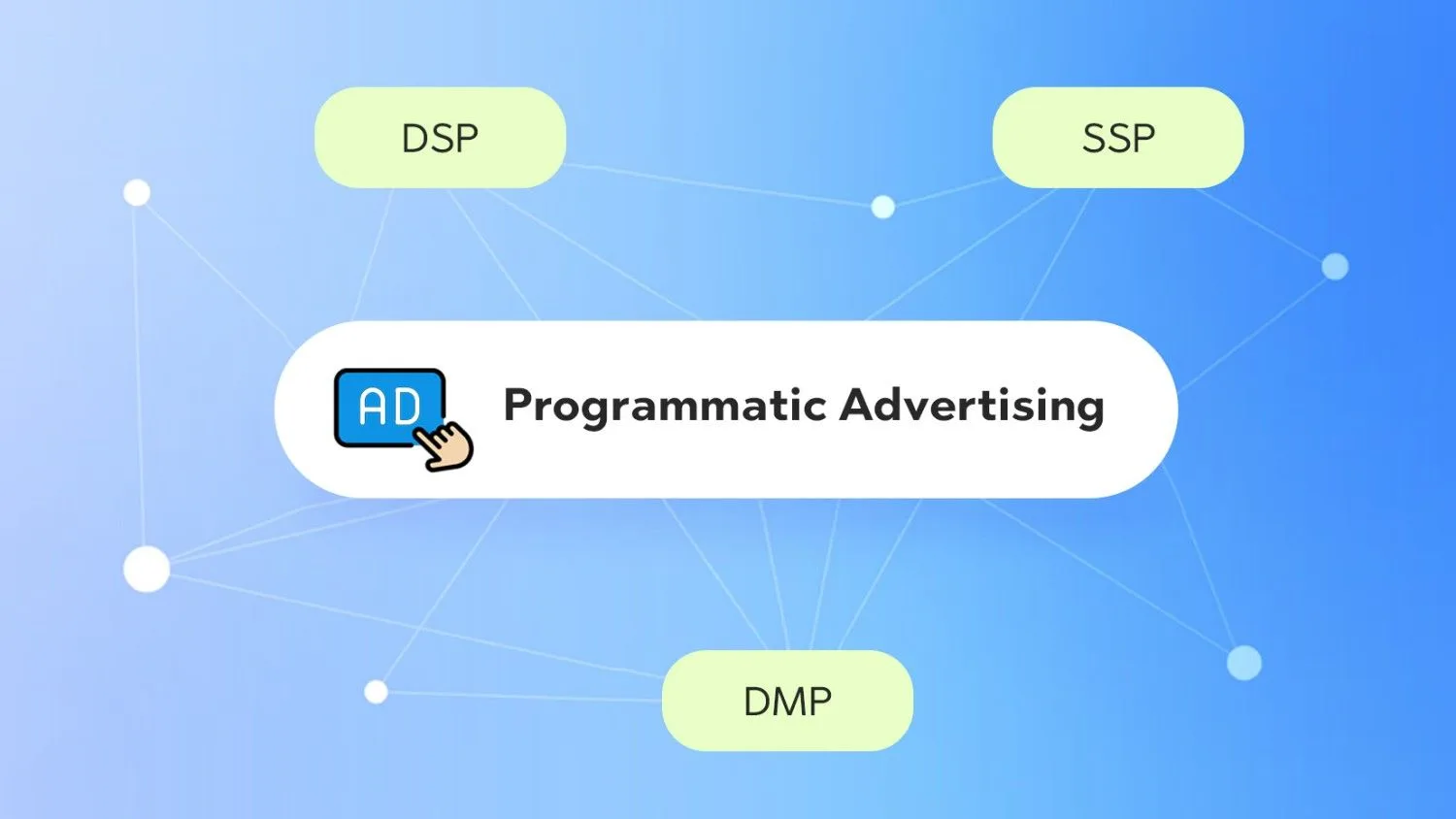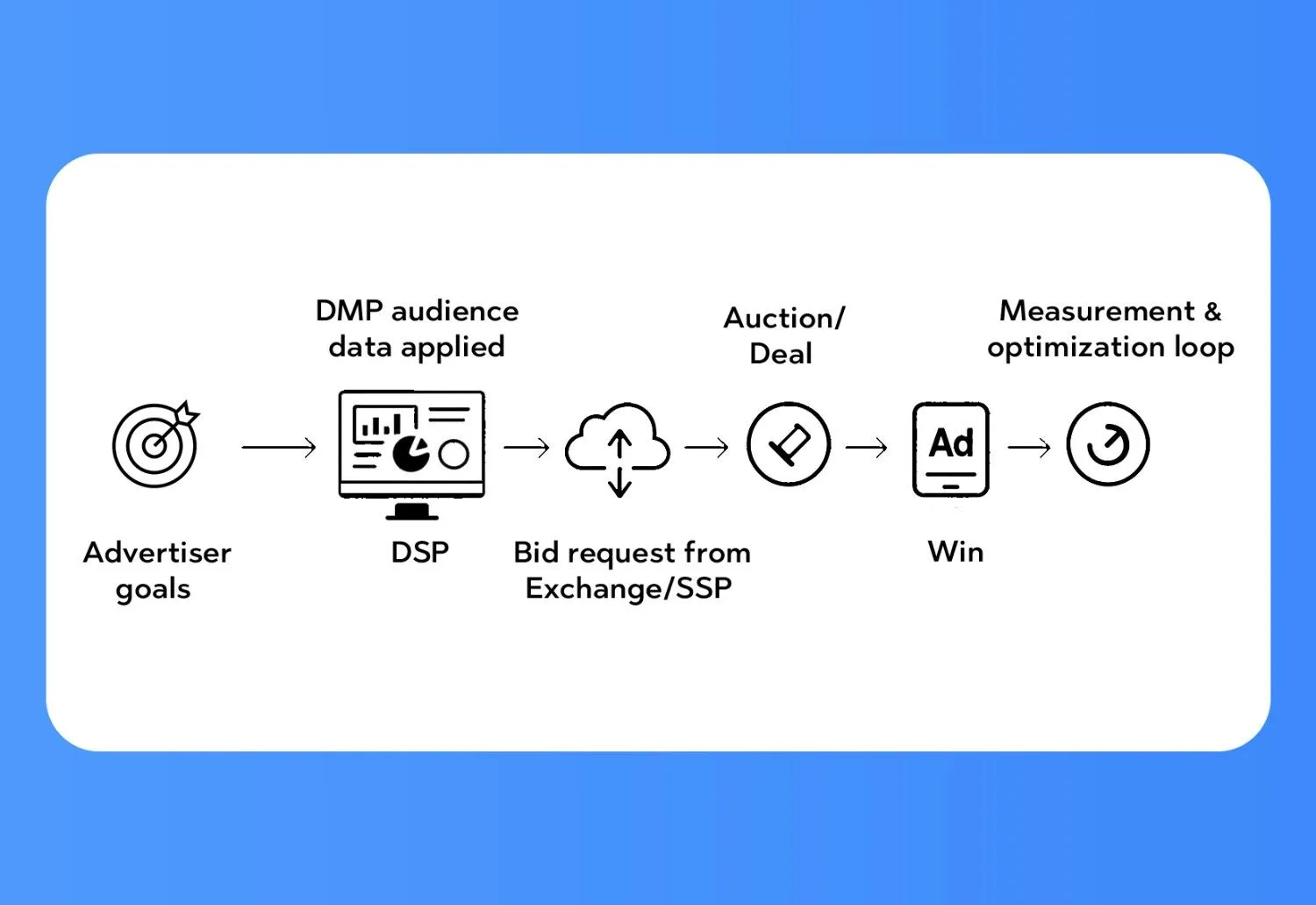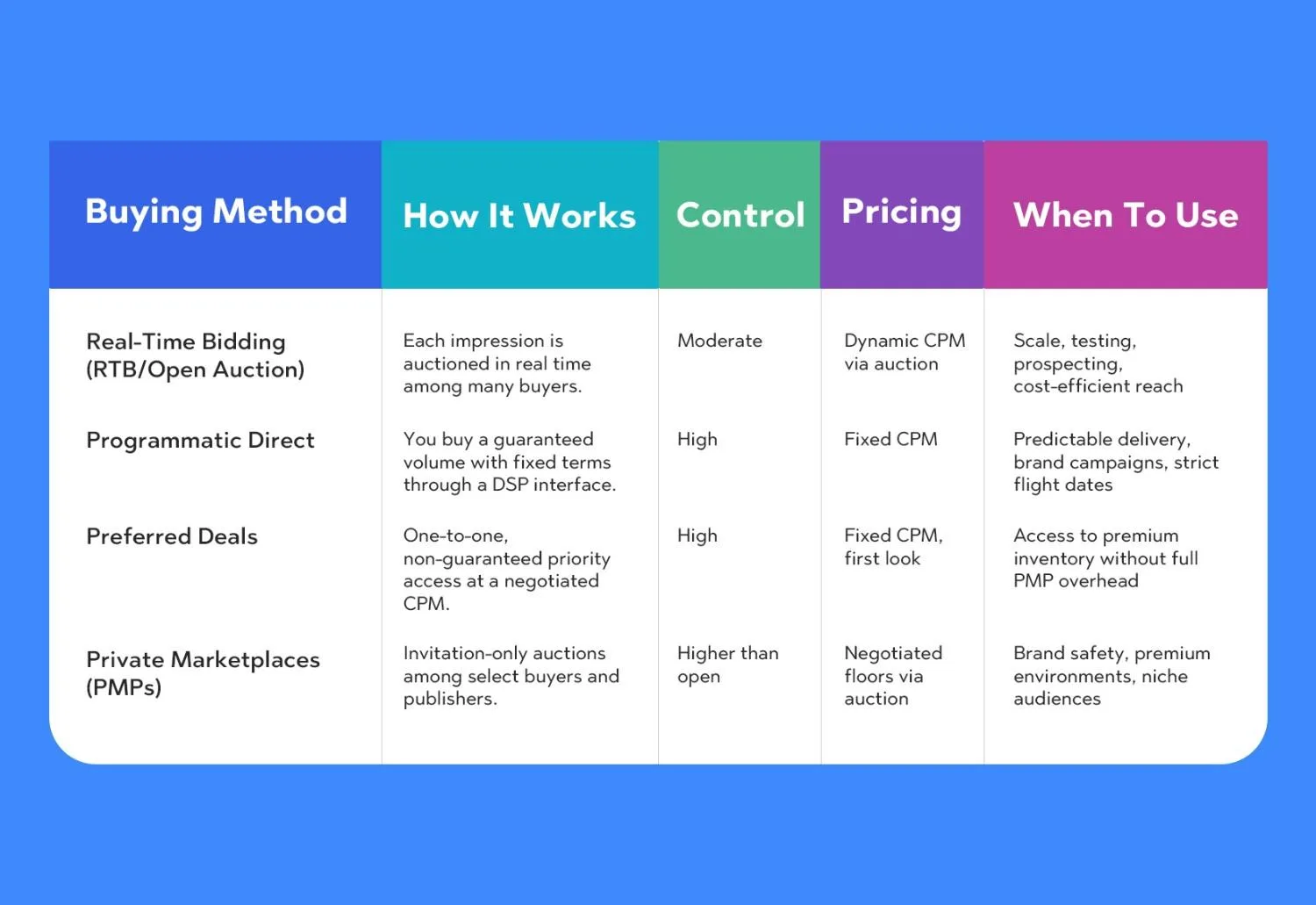Rahul Guleria
SEO Executive

Not long ago, buying digital ads meant endless emails, spreadsheets, and phone calls. You picked a site, negotiated a placement, sent over creative, then crossed your fingers. It worked, sort of. It also moved at the speed of paperwork.
Programmatic advertising changed the tempo. Today, algorithms handle the grunt work—matching the right ad to the right person at the right moment—while marketers focus on strategy and creative. It’s faster, smarter, and far more measurable.
AI-powered search and AI Overviews reinforce the same principle: automation + data beats guesswork. Programmatic delivers that combo in spades with real-time bidding, machine learning optimization, and precision targeting that turns budgets into impact.
This programmatic advertising guide walks you through what it is, how it works, the tools involved, and battle-tested best practices. If you’re a marketer looking for clarity and control, you’re in the right place.
Short definition: Programmatic advertising is the automated use of software and algorithms to buy and place digital ads in real time.
Put simply, you set goals and guardrails; machines handle the auctions and placements across the open web, apps, videos, and even Connected TV. The result: less manual buying, more data-driven outcomes.
Why it matters now: audiences fragment across devices; cookies wobble; attention is scarce. Programmatic helps you chase outcomes rather than inventory, optimizing every impression against the result you care about—clicks, views, leads, or sales.
At its core, programmatic advertising is an automated way to purchase and manage online ads, which falls under the broader scope of what is paid media advertising.
Here’s the simple flow marketers love to show on one slide:
You define objectives (awareness, leads, sales), audience parameters, budgets, bids, pacing, frequency caps, and creative.
Your Demand-Side Platform (DSP) plugs into ad exchanges and supply sources with billions of impressions.
The DSP selects the best creative, the page/app loads, and your ad appears—usually in under 100 milliseconds.

Advertiser goals → DSP → (DMP audience data applied) → Bid request from Exchange/SSP → Auction/Deal → Win → Ad delivered → Measurement & optimization loop
Every step feeds the next. Performance data trains the algorithm, which refines bids, audiences, and creative rotation in near real time.
The DSP is your mission control. It’s where you create campaigns, set targeting, upload creative, apply audience segments, and choose bidding strategies. It evaluates each available impression and decides whether to bid and how much.
The SSP is the publisher’s side of the house. It manages a publisher’s inventory, sets price floors, and connects that inventory to exchanges and DSPs. Think of it as the logistics network that makes premium impressions available to buyers.
The marketplace where impressions are bought and sold. Exchanges facilitate RTB auctions and route bid requests between SSPs and DSPs at scale.
These platforms store and activate audience data—first-party (your own), second-party (partners), and third-party data. They build segments (e.g., “cart abandoners,” “loyal customers”) and pass those segments to DSPs for smarter targeting and lookalike modeling.
Use this quick comparison to pick the right buying method for your campaign.

Buying Method | How It Works | Control | Pricing | When To Use |
|---|---|---|---|---|
Real-Time Bidding (RTB/Open Auction) | Each impression is auctioned in real time among many buyers. | Moderate | Dynamic CPM via auction | Scale, testing, prospecting, cost-efficient reach |
Programmatic Direct | You buy a guaranteed volume with fixed terms through a DSP interface. | High | Fixed CPM | Predictable delivery, brand campaigns, strict flight dates |
Preferred Deals | One-to-one, non-guaranteed priority access at a negotiated CPM. | High | Fixed CPM, first look | Access to premium inventory without full PMP overhead |
Private Marketplaces (PMPs) | Invitation-only auctions among select buyers and publishers. | Higher than open | Negotiated floors via auction | Brand safety, premium environments, niche audiences |
Rule of thumb: Start with RTB to learn cheaply, then layer PMPs/preferred deals when you need placement quality, brand safety, and more control.
Automation slashes the manual work of outreach, trafficking, and reconciliation. You move faster and spend time on messaging, testing, and strategy.
Blend contextual, first-party, and modeled data to reach people by behavior, intent, or stage in the funnel. Machine learning uncovers micro-segments humans miss.
Algorithms observe performance and adjust bids, budgets, and creative rotation mid-flight. Poor placements get throttled; winners get more budget.
One plan can stretch across display, native, video, audio, in-app, and CTV—with unified frequency caps and deduplicated reporting.
You see where your money goes—domain-level reporting, viewability, brand safety controls, and post-view attribution. Pair that with incrementality tests to prove lift.
Dynamic creative optimization (DCO) swaps headlines, images, and CTAs by audience, location, weather, or product feed. More relevance, less waste.
Bots, spoofed domains, and hidden iframes can siphon budget. Without controls, numbers look good, but outcomes suffer.
Open web scale can expose ads to sensitive or unsuitable content. You need allowlists, contextual filters, and verification.
Regulations and cookie deprecation reduce the easy modes of targeting. Marketers must lean on first-party data, clean rooms, and contextual signals.
DSPs feel like cockpit dashboards. Fees, auction mechanics, and reporting definitions can be opaque, especially to newcomers.
Cross-device identity, CTV attribution, and walled gardens complicate a clean read. It takes planning to measure what matters.
Select DSPs and SSPs with third-party verification, strong brand-safety controls, and clear fee structures. Ask about supply path optimization (SPO) to minimize hops and hidden markups.
Turn on pre-bid filters, invalid traffic detection, and domain/app verification. Combine MOAT/IAS/DoubleVerify-style tools with your DSP’s native protections.
Prioritize first-party audiences (site visitors, CRM lists, past purchasers). Build lookalikes. Use contextual segments when identifiers are thin.
Algorithmic bidding is powerful, yet it needs boundaries. Set frequency caps, brand-safety tiers, and outcome-based KPIs. Review search terms, placements, and pacing daily in ramp-up.
Run structured A/B tests: message, creative format, audience, landing page. Document learnings. Scale winners and retire losers fast.
Faster pages, clearer offers, and intent-matched content lift conversion rate. Don’t pay for clicks only to lose people to slow loads and vague CTAs.
Create variations for each format: display, native, in-stream, out-stream, and CTV. Refresh every 2–4 weeks to avoid fatigue.
Use multi-touch models or media mix modeling where possible. Validate with lift tests or geo-split experiments so you don’t over-credit last clicks.
Publish an internal playbook: data usage rules, bidding strategies, safety tiers, blocklists/allowlists, and escalation paths. New team members ramp faster and mistakes drop.
Bidding already leans on ML, but the next wave goes deeper: creative generation at scale, predictive audiences based on real-time signals, and on-the-fly budget reallocation by marginal return.
Connected TV inventory is exploding. Expect more shoppable formats, better household reach curves, and cleaner attribution through device graphs and privacy-safe IDs.
First-party data, clean rooms, and contextual AI replace third-party cookie crutches. Cohort-based targeting, publisher APIs, and identity partners will mature fast.
Dynamic creative will use zero- and first-party signals that users willingly share. Expect experiences that feel helpful instead of invasive.
Platforms will expose clearer paths from buyer to publisher, reducing fees, fraud, and latency. Quality over quantity becomes the norm.
Programmatic advertising automates the heavy lifting of buying and placing ads so marketers can focus on outcomes. You set goals. The system uses data, algorithms, and exchanges to find opportunities and win the right impressions—across web, apps, video, and CTV.
Adopt it because it’s efficient. Keep it because it’s accountable. Master it because it will be the backbone of paid distribution in a privacy-first, AI-driven world. Start with clean data and clear KPIs, pair automation with human judgment, and keep testing.
When you’re ready to integrate programmatic into a broader paid strategy, explore our approach to paid media advertising—then plug your best creative into a plan that scales.
Programmatic advertising is the automated buying and placement of digital ads using software and algorithms. It evaluates each available impression, bids in real time, and serves the best creative to the right user—at scale.
Marketers set goals and inputs in a DSP. The DSP connects to ad exchanges and receives bid requests from SSPs. Either an open auction (RTB) or a pre-negotiated deal determines if you win. If you do, your ad renders instantly. Performance data flows back to optimize bids, budgets, and creative.
Four common methods:
It turns media buying into a measurable, real-time system. You reach more of the right people, waste less spending, and prove value with transparent reporting and controlled experiments.
Programmatic is the overall automated ecosystem, including RTB and direct deals. RTB is one buying method within programmatic that uses auctions to price each impression on the fly.